Just In
- 6 hrs ago

- 7 hrs ago

- 10 hrs ago

- 10 hrs ago

Don't Miss
- News
 King Charles Grants Royal Assent: UK's Rwanda Deportation Plan Now Law
King Charles Grants Royal Assent: UK's Rwanda Deportation Plan Now Law - Sports
 T20 World Cup 2024: Toss up between Sanju Samson and KL Rahul ahead of big selection meeting
T20 World Cup 2024: Toss up between Sanju Samson and KL Rahul ahead of big selection meeting - Movies
 Giorgia Andriani Turns Up Heat As She Flaunts Toned Body In Black Bra, Skirt Post Gym Session- VIRAL VIDEO
Giorgia Andriani Turns Up Heat As She Flaunts Toned Body In Black Bra, Skirt Post Gym Session- VIRAL VIDEO - Finance
 IndusInd Bank Q4 Results: PAT Soars 15% To Rs 2,349 Cr, NII Climbs 15%; 165% Dividend Declared
IndusInd Bank Q4 Results: PAT Soars 15% To Rs 2,349 Cr, NII Climbs 15%; 165% Dividend Declared - Automobiles
 Royal Enfield Unveils Revolutionary Rentals & Tours Service: Check Out All Details Here
Royal Enfield Unveils Revolutionary Rentals & Tours Service: Check Out All Details Here - Technology
 Elon Musk’s X Is Launching a TV App Similar to YouTube for Watching Videos
Elon Musk’s X Is Launching a TV App Similar to YouTube for Watching Videos - Education
 AICTE introduces career portal for 3 million students, offering fully-sponsored trip to Silicon Valley
AICTE introduces career portal for 3 million students, offering fully-sponsored trip to Silicon Valley - Travel
 Escape to Kalimpong, Gangtok, and Darjeeling with IRCTC's Tour Package; Check Itinerary
Escape to Kalimpong, Gangtok, and Darjeeling with IRCTC's Tour Package; Check Itinerary
Rath Yatra 2021: Everything You Need To Know About Rath Yatra of Jagannath In Puri
The word 'Jagannath' or 'Jagannatha' can be translated as the 'Lord of the Universe'. Lord Jagannath is an important deity in not only Hinduism but also in Buddhism and Jainism. Within Hinduism, the Vaishnavas or the followers of Lord Maha Vishnu see Lord Jagannath as a form of Lord Krishna or the eighth avatar of Lord Maha Vishnu. For the Shaivites, or the followers of Lord Shiva, Lord Jagannath is a form of Bhairava.
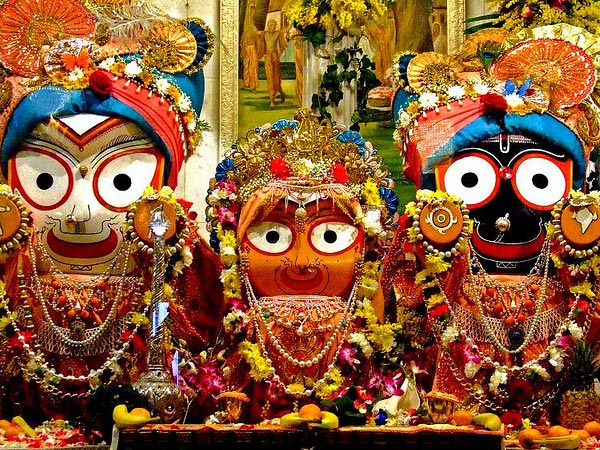
To the Buddhists, the Lord stands for the triad of Buddha Sangha Dhamma. The Jains consider the Lord to be the derivation of Jeenanath of Jainism. Some literature of the Odia tradition considers Lord Jagannath to be the equivalent of Buddha who is often mentioned as the ninth avatar of Lord Maha Vishnu.
The Rath Yatra of Puri is an important festival for the devotees of Lord Jagannath. This year, the Rath Yatra will commence on 12 July. The festival in public was earlier cancelled by the Supreme Court of India in view of the COVID-19 pandemic but later the SC declared it open and said the Centre and the temple management have to deal with managing the Yatra this year.
To commemorate this occasion, we bring you some facts that you must know about Lord Jagannath and the Rath Yatra of Puri. Read on to know more.
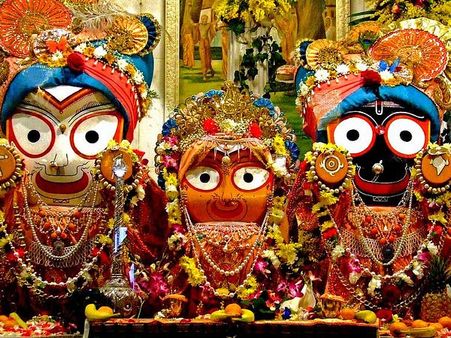
The Idol Of Lord Jagannath
The idol of Lord Jagannath is carved on a wooden stump. The most prominent features are his round and large eyes. He has two stumps that stand for his hands. He lacks feet and has a symmetrical face. The rites of worship are largely uncommon and unique.

The History Of Lord Jagannath
The tradition of the worship of Lord Jagannath goes back to the Rig Veda though the traditional Dashavatar does not list his name. You will find mention of his name in texts like the Ramayana, Mahabharata and the Puranas.
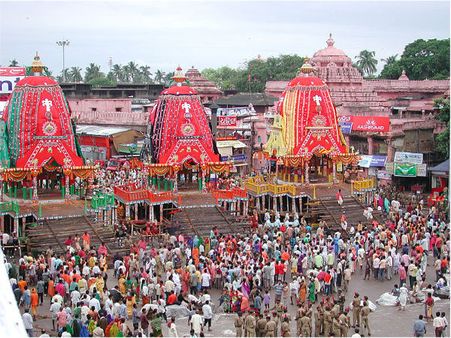
Significance Of The Lord Jagannath Temple at Puri
The temple of Lord Jagannath at Puri is considered to be very important and is one among the Char Dhams or the four important pilgrimage sites for the Vaishnavites. Lord Jagannath is a very important deity in the states of Orissa, West Bengal, Chhattisgarh, Jharkhand, Gujarat, Assam, Bihar, Tripura and Manipur. The Lord is also very sacred for the Hindus who live in Bangladesh. The Temple dedicated to Lord Jagannath at Puri is perhaps the most ancient ones.
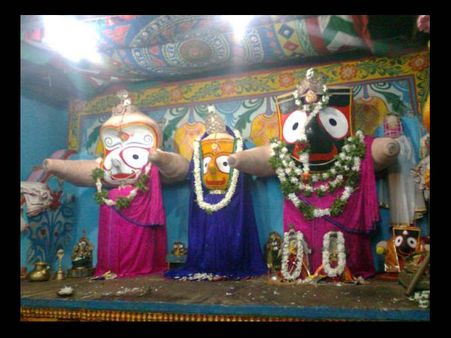
The Celebration Of Rath Yatra
The actual celebration begins a lot earlier. The devotees gather to construct gigantic rathas or chariots for the Lord Jagannath and his siblings, Balarama and Subhadra. These three chariots are the most important parts of the Rath Yatra. The main chariot or the chariot for Lord Jagannath is to be 45.6 feet tall. It has 18 large wheels and is called Nandighosa. Balaram's chariot is a little smaller at 45 feet and has 16 wheels. It is called Taladhvaja. Subhadra's chariot is called Devadalana and consists of 14 wheels. It is made to be 44.6 high. These chariots are decorated with colours and flowers.
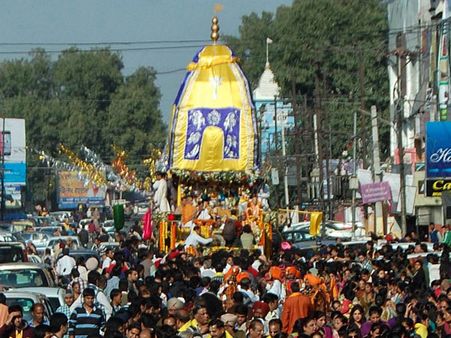
The Procession Of The Rath Yatra
The procession starts when the chariots of Lord Jagannath and his siblings, Balabhadra and Subhadra, are taken out on the Bada Danda. Bada Danda is the main street of Puri. The devotees and volunteers pull the ropes of the chariot to take them to the Sri Gundicha Temple. Sri Gundicha Temple is said to be the home of the deities' maternal aunt or Mausi. Here, they spend 9 days, after which they return to Puri. At the Gundicha Temple, they are served sweet pancakes that are special prasad offered here.
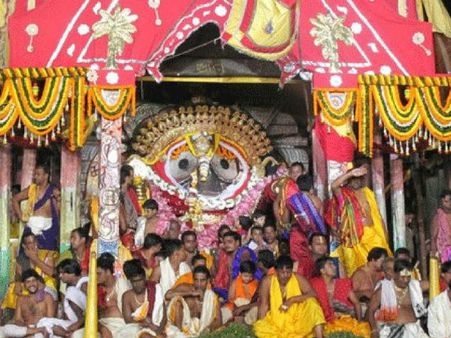
The Ritual Of Chhera Pahara
Chhera Pahara is a famous ritual of the Jagannath Puri Rath Yatra. The Gajapati King uses a gold broom to sweep the area around the deities and their chariots. He then sprinkles sandalwood water and powder on them. This ritual shows that in front of Lord Jagannath everybody is equal.
-
 astrologyJagannath Rath Yatra 2023 Day 8: Know About Bahuda Yatra Schedule, Rituals And Significance
astrologyJagannath Rath Yatra 2023 Day 8: Know About Bahuda Yatra Schedule, Rituals And Significance -
 yoga spiritualityJagannath Rath Yatra 2023 Day 5: Know About The Schedule, Rituals And Significance
yoga spiritualityJagannath Rath Yatra 2023 Day 5: Know About The Schedule, Rituals And Significance -
 yoga spiritualityJagannath Rath Yatra 2023 Day 7 : Know About The Schedule, Rituals And Significance
yoga spiritualityJagannath Rath Yatra 2023 Day 7 : Know About The Schedule, Rituals And Significance -
 yoga spiritualityJagannath Rath Yatra 2023: Why Lord Jagannath Chariot Halt At Mazar (Tomb)?
yoga spiritualityJagannath Rath Yatra 2023: Why Lord Jagannath Chariot Halt At Mazar (Tomb)? -
 yoga spiritualityJagannath Rath Yatra 2023 Day 1: Know About The Schedule, Rituals And Significance
yoga spiritualityJagannath Rath Yatra 2023 Day 1: Know About The Schedule, Rituals And Significance -
 yoga spiritualityJagannath Rath Yatra 2023: Day-Wise Schedule, All You Need To Know
yoga spiritualityJagannath Rath Yatra 2023: Day-Wise Schedule, All You Need To Know -
 yoga spiritualityJagannath Rath Yatra 2023: How Gold Broom Is Associated With Chariot Festival Rituals
yoga spiritualityJagannath Rath Yatra 2023: How Gold Broom Is Associated With Chariot Festival Rituals -
 yoga spiritualityJagannath Rath Yatra 2023: Know Traditional Medicines Used To Treat Lord Jagannath Ahead Of Chariot Festival
yoga spiritualityJagannath Rath Yatra 2023: Know Traditional Medicines Used To Treat Lord Jagannath Ahead Of Chariot Festival -
 yoga spiritualityJagannath Rath Yatra 2023: Why Does Lord Jagannath Fall Sick Every Year? Know The Reason Behind It
yoga spiritualityJagannath Rath Yatra 2023: Why Does Lord Jagannath Fall Sick Every Year? Know The Reason Behind It -
 astrologyRath Yatra 2023: Chant These Mantras According To Your Zodiac Sign To Get Maximum Benefits
astrologyRath Yatra 2023: Chant These Mantras According To Your Zodiac Sign To Get Maximum Benefits -
 yoga spiritualityJagannath Rath Yatra 2023: The Secret Behind The Mahaprasad Preparation
yoga spiritualityJagannath Rath Yatra 2023: The Secret Behind The Mahaprasad Preparation -
 yoga spiritualityJagannath Rath Yatra 2023: Interesting Facts About The Rath Yatra Chariots
yoga spiritualityJagannath Rath Yatra 2023: Interesting Facts About The Rath Yatra Chariots


 Click it and Unblock the Notifications
Click it and Unblock the Notifications



